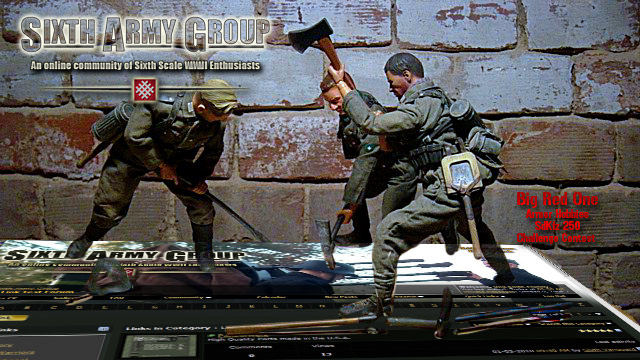Tony Barton
Company Commander
Seaforth Highlanders 1890
In the early 20th century there was a tremendous vogue for collecting coloured cigarette cards, which were often illustrated with colourful subjects such as “ Regiments of the British Army “. Many of the original artworks for these were collected a few years back into a fine book by Schiffer, which was kindly given to me by Andy Sheppard some years back. It’s been quite an inspiration ever since. Unashamedly inspired by such postcards, this figure shows the last full dress worn by Highland Regiments in the late 19th century and in the Edwardian period leading up to the Great War.
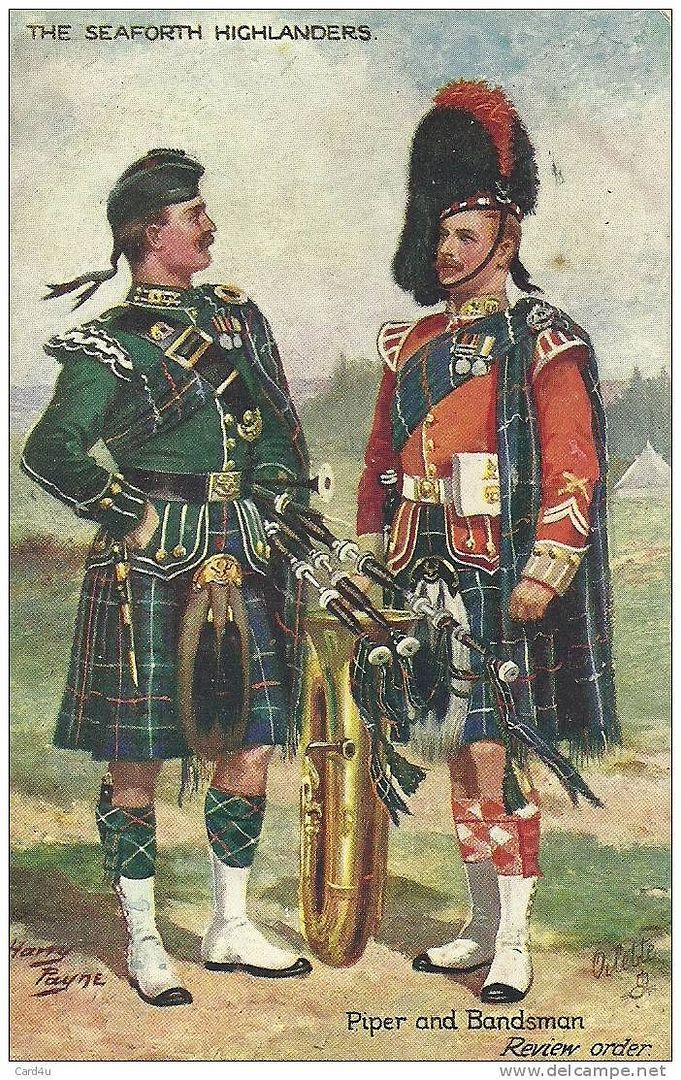
That one showing musicians, whose rig was slightly grander than the ordinary private.
Highland dress is a kind of operatic version of what had once been a simple regional peasant dress , a trend which has been followed in the military of many nations : one only has to think of Hussars , Zouaves and Cossacks. Highlanders were recruited for the army as early as 1740, and very quickly started a stylisation of their dress which took it far from the original.

The origins of Highland dress are very obscure , the earliest definite depictions being from the 16th century . Despite the enthusiasm of Gaelic folklorists, we don’t really know how old it is, though its simplicity suggest antiquity .It’s basis is a large piece of cloth, the great plaid, straight from the loom and worn draped around the person, with parallels with the Roman toga.It acted as main garment , cloak and bed. But history does not record its use earlier, so the rest is speculation.
Originally , the kilt itself was just made by pleating the lower part of the great plaid . As early as the 1760s that was being replaced by the little kilt,cut from old plaids, which became formalised by 1800 into the kilt much as we know it today.
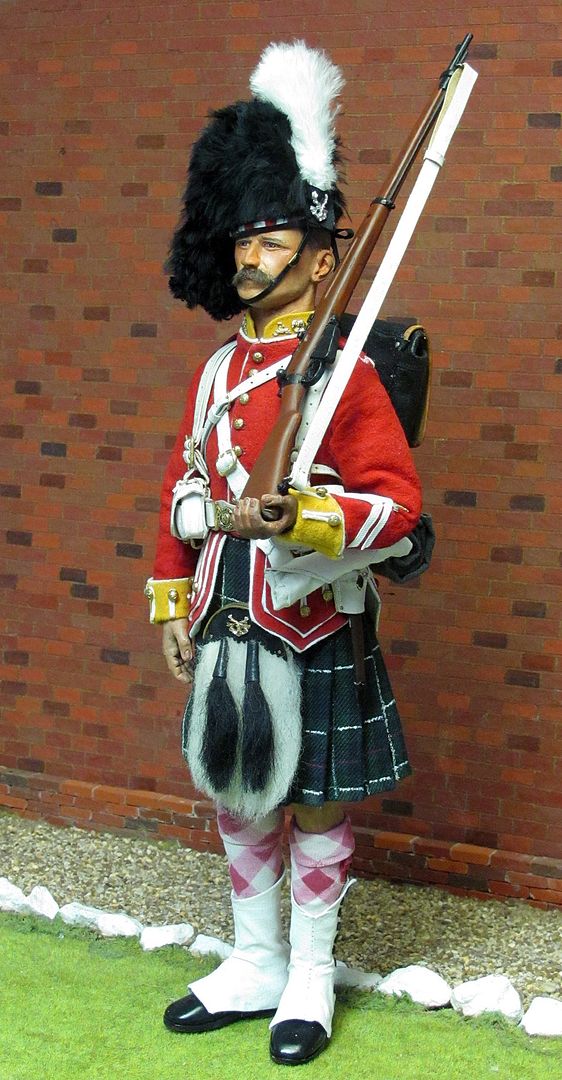
The real formalisation of the military outfits takes off in the 1820s after George IV’s visit to Scotland , which spawned the whole fashion for everything Scots and Romantick, and from then on it all got rather out of hand, with special Scots doublets, enormous hairy sporrans ( just a purse originally ) and the fantastic mutation of the flat knitted bonnet into a feathered monstrosity nearly two foot high, along with dirks, skian dubhs, cairngorm brooches and buckled shoe.The whole confection achieves a decidedly impressive if sometimes ludicrous air. What saves it from comedy is that it was worn by some very hard men .
They were Victorian icons , personal favourites of the Queeen , and perhaps given more attention than their exploits deserved ( at least the rest of the army thought so ) but they were always in the public eye as the ideal of the Imperial soldier . Countless magazine illustrations depicted them , and by 1900 they were a “brand” known round the world , but by the 1890s they were no longer made up entirely of real Highlanders , since like all regiments they recruited pretty well anyone suitable. Their ranks contained men from all over the home countries, with a heavy preponderance of Scots.
*************************************************************************************
I’ve set my figure in the 1890s, earlier than many of the postcards, because I wanted also to show the Slade-Wallace equipment, which was introduced in 1888 just before the issue of the first magazine rifle, the Lee-Metford.This replaced the Valise equipment familiar from the Zulu War. There were detail changes later, mostly to the pouches as they were adapted for different ammunition , but the belt and braces remained normal as parade dress well into the 20th century.
Our figure has the full field kit, with haversack , waterbottle, messtin and valise, as well as pouches and bayonet. The greatcoat is carried rolled at the back.
The Seaforths were a recently amalagmated regiment, with the combination of the 72nd and the 78th, and to avoid strife they wore both collar dogs from the parent units.
The kilt is Government tartan with overstripes of white and red, known as McKenzie .

The feather bonnet mystifies many people : it’s actually the old flat knitted bonnet ( like a beret ) stretched and stiffened up into a dome, with ostrich feathers applied all over the surface, then five feather tails attached to swing at the side. It weighs very little, since it’s mostly feathers and air .
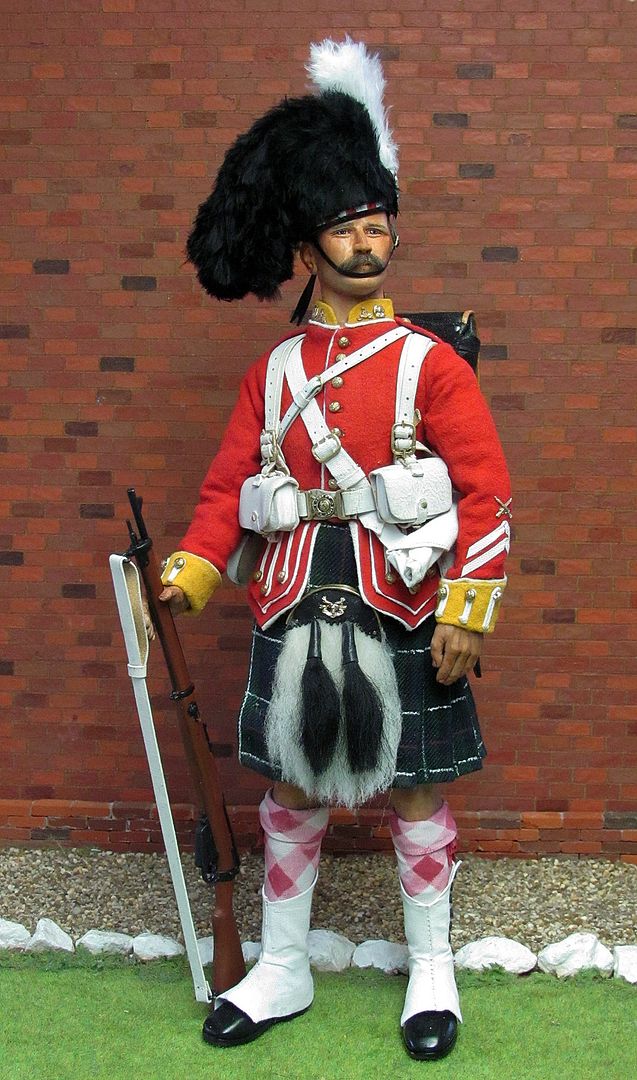
Believe it or not , men actually took part in field manouvers dressed like this as late as the 1890s ( I have a postcard showing Guards changing station by routemarching from London to Aldershot, wearing full dress and field equipment as late as 1904 ) . From 1900 it was usual to wear something more practical, keeping this splendour for parades. In the field of course, khaki uniforms were normal after the Egyptian expedition of 1881/2 , and by 1914 Britain probably led the way in the modernity of her soldiers’ field kit , especially after the salutary lesson of the Boer War .
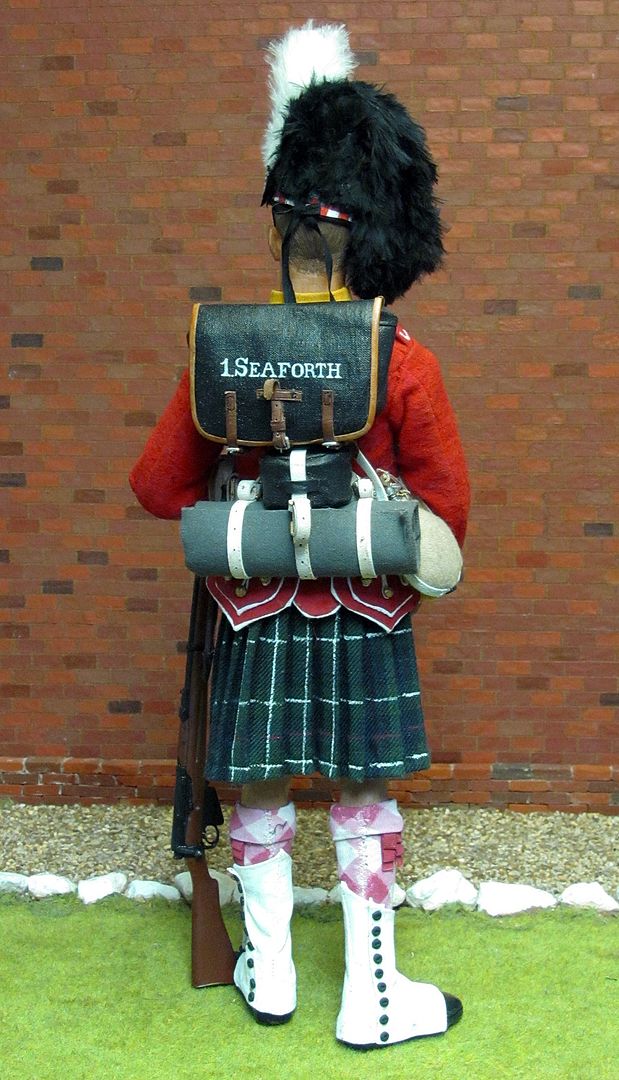
Making the figure...
A slow careful undertaking , because I wanted to keep him clean and sharp, which can be surprisingly difficult when handling a figure a lot.
DML body with legs anatomised to insert Sculpey knees.
Bonnet blocked from felt , with marabout feathers. The tails are cut from a miniature feather boa and sewn on the top. Cockade from stiffened silk with pewter stag badge.

Doublet from scarlet and white brushed cotton , with BGT plastic buttons. On the left forearm are his long-service and marksman badges .
Kilt from Sideshow with painted overstripes. Pin out the kilt on a cork board so it’s taut, then add the white stripes using a fine white paint pen and a ruler. Same for red stripes then overwork them in red.
Sporran from leather, brass cantle, mohair beard and tassels.
Hose from a T-shirt, painted.
Spats from white cotton, Fimo buttons.
Slade-Wallace equipment in goatskin with brass fittings cast for me in Birmingham, with the very smallest brass pins used as rivets. Some buckles from brass wire.
Valise is gloss-painted canvas edged with leather.
Haversack white cotton, rolled as you see it.
Waterbottle cast resin with felt cover.
Messtin is cast metal, with oilskin cover.
Lee-Metford Rifle in resin.
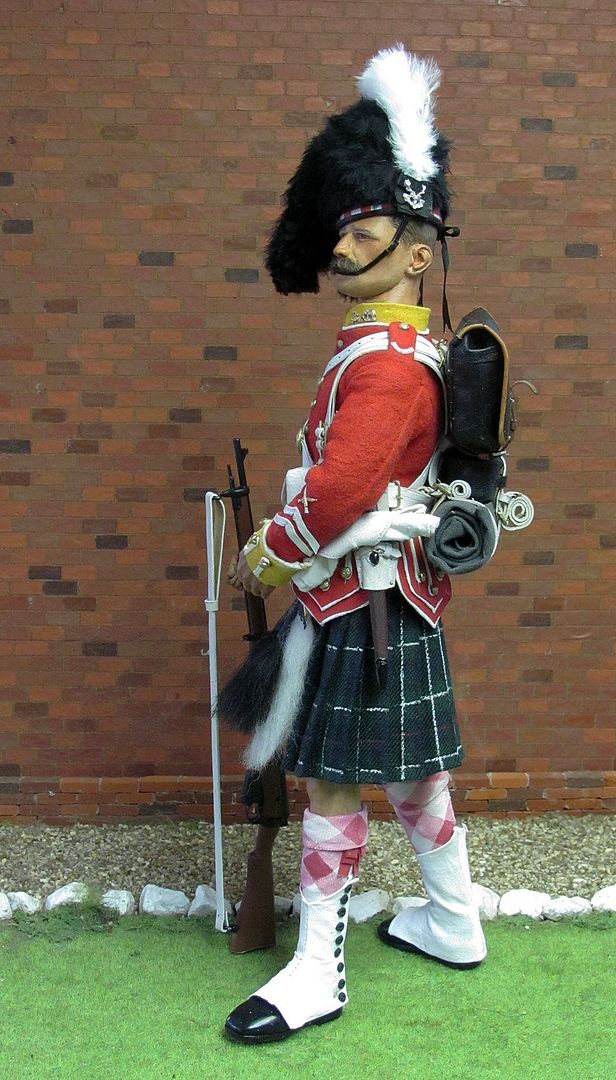

******************************************************************************************************
And a final one showing walking-out dress :~
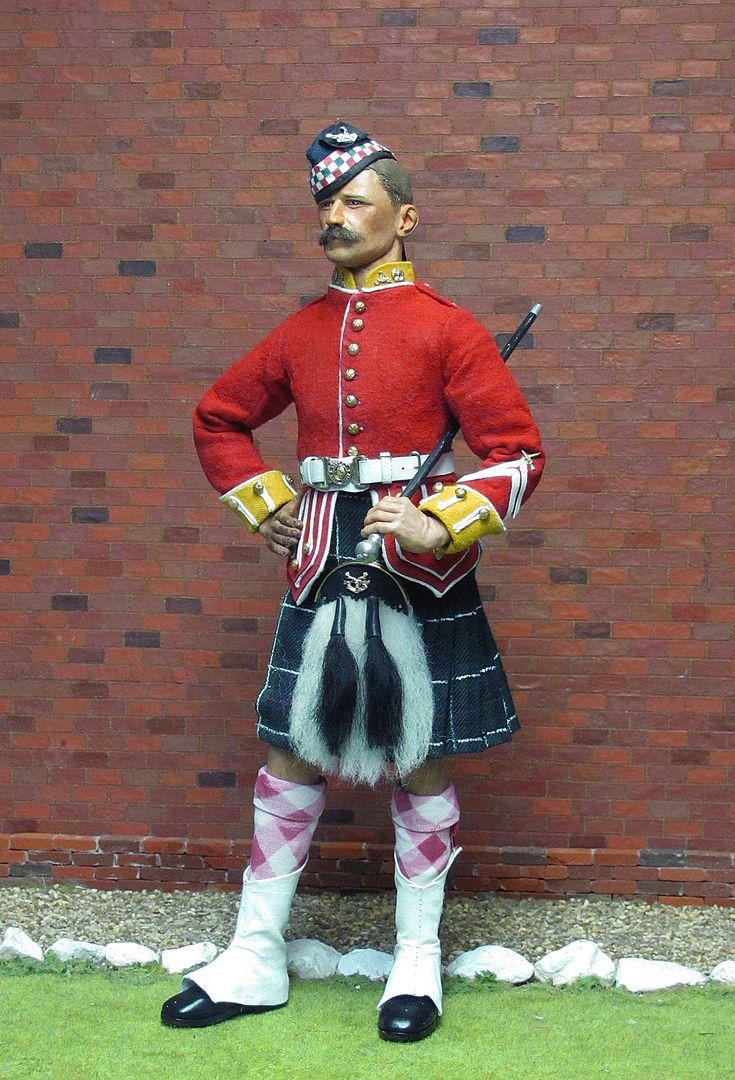
Thanks to Jim Farnham for the kilt.
*********************************************************************************************
In the early 20th century there was a tremendous vogue for collecting coloured cigarette cards, which were often illustrated with colourful subjects such as “ Regiments of the British Army “. Many of the original artworks for these were collected a few years back into a fine book by Schiffer, which was kindly given to me by Andy Sheppard some years back. It’s been quite an inspiration ever since. Unashamedly inspired by such postcards, this figure shows the last full dress worn by Highland Regiments in the late 19th century and in the Edwardian period leading up to the Great War.

That one showing musicians, whose rig was slightly grander than the ordinary private.
Highland dress is a kind of operatic version of what had once been a simple regional peasant dress , a trend which has been followed in the military of many nations : one only has to think of Hussars , Zouaves and Cossacks. Highlanders were recruited for the army as early as 1740, and very quickly started a stylisation of their dress which took it far from the original.

The origins of Highland dress are very obscure , the earliest definite depictions being from the 16th century . Despite the enthusiasm of Gaelic folklorists, we don’t really know how old it is, though its simplicity suggest antiquity .It’s basis is a large piece of cloth, the great plaid, straight from the loom and worn draped around the person, with parallels with the Roman toga.It acted as main garment , cloak and bed. But history does not record its use earlier, so the rest is speculation.
Originally , the kilt itself was just made by pleating the lower part of the great plaid . As early as the 1760s that was being replaced by the little kilt,cut from old plaids, which became formalised by 1800 into the kilt much as we know it today.

The real formalisation of the military outfits takes off in the 1820s after George IV’s visit to Scotland , which spawned the whole fashion for everything Scots and Romantick, and from then on it all got rather out of hand, with special Scots doublets, enormous hairy sporrans ( just a purse originally ) and the fantastic mutation of the flat knitted bonnet into a feathered monstrosity nearly two foot high, along with dirks, skian dubhs, cairngorm brooches and buckled shoe.The whole confection achieves a decidedly impressive if sometimes ludicrous air. What saves it from comedy is that it was worn by some very hard men .
They were Victorian icons , personal favourites of the Queeen , and perhaps given more attention than their exploits deserved ( at least the rest of the army thought so ) but they were always in the public eye as the ideal of the Imperial soldier . Countless magazine illustrations depicted them , and by 1900 they were a “brand” known round the world , but by the 1890s they were no longer made up entirely of real Highlanders , since like all regiments they recruited pretty well anyone suitable. Their ranks contained men from all over the home countries, with a heavy preponderance of Scots.
*************************************************************************************
I’ve set my figure in the 1890s, earlier than many of the postcards, because I wanted also to show the Slade-Wallace equipment, which was introduced in 1888 just before the issue of the first magazine rifle, the Lee-Metford.This replaced the Valise equipment familiar from the Zulu War. There were detail changes later, mostly to the pouches as they were adapted for different ammunition , but the belt and braces remained normal as parade dress well into the 20th century.
Our figure has the full field kit, with haversack , waterbottle, messtin and valise, as well as pouches and bayonet. The greatcoat is carried rolled at the back.
The Seaforths were a recently amalagmated regiment, with the combination of the 72nd and the 78th, and to avoid strife they wore both collar dogs from the parent units.
The kilt is Government tartan with overstripes of white and red, known as McKenzie .

The feather bonnet mystifies many people : it’s actually the old flat knitted bonnet ( like a beret ) stretched and stiffened up into a dome, with ostrich feathers applied all over the surface, then five feather tails attached to swing at the side. It weighs very little, since it’s mostly feathers and air .

Believe it or not , men actually took part in field manouvers dressed like this as late as the 1890s ( I have a postcard showing Guards changing station by routemarching from London to Aldershot, wearing full dress and field equipment as late as 1904 ) . From 1900 it was usual to wear something more practical, keeping this splendour for parades. In the field of course, khaki uniforms were normal after the Egyptian expedition of 1881/2 , and by 1914 Britain probably led the way in the modernity of her soldiers’ field kit , especially after the salutary lesson of the Boer War .

Making the figure...
A slow careful undertaking , because I wanted to keep him clean and sharp, which can be surprisingly difficult when handling a figure a lot.
DML body with legs anatomised to insert Sculpey knees.
Bonnet blocked from felt , with marabout feathers. The tails are cut from a miniature feather boa and sewn on the top. Cockade from stiffened silk with pewter stag badge.

Doublet from scarlet and white brushed cotton , with BGT plastic buttons. On the left forearm are his long-service and marksman badges .
Kilt from Sideshow with painted overstripes. Pin out the kilt on a cork board so it’s taut, then add the white stripes using a fine white paint pen and a ruler. Same for red stripes then overwork them in red.
Sporran from leather, brass cantle, mohair beard and tassels.
Hose from a T-shirt, painted.
Spats from white cotton, Fimo buttons.
Slade-Wallace equipment in goatskin with brass fittings cast for me in Birmingham, with the very smallest brass pins used as rivets. Some buckles from brass wire.
Valise is gloss-painted canvas edged with leather.
Haversack white cotton, rolled as you see it.
Waterbottle cast resin with felt cover.
Messtin is cast metal, with oilskin cover.
Lee-Metford Rifle in resin.


******************************************************************************************************
And a final one showing walking-out dress :~

Thanks to Jim Farnham for the kilt.
*********************************************************************************************
